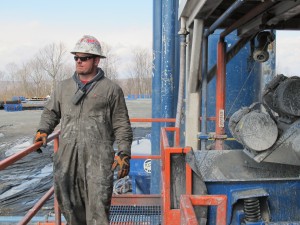Obama aims to limit methane emissions from oil and gas industry

Susan Phillips / StateImpact Pennsylvania
A worker stands by a natural gas well in Susquehanna County, Pa.
President Obama has made methane his latest target for reducing greenhouse gas emissions. In an announcement today, officials from the Environmental Protection Agency laid out plans to enact new regulations limiting methane emissions from oil and gas production. The goal is to cut methane leaks by 40 to 45 percent by 2025, using 2012 as the baseline.
Environmental activists and climate scientists have been urging Obama to tackle methane emissions. Methane is a powerful greenhouse gas, which is 80 times more potent than carbon dioxide emissions in the short term. The announcement marks the president’s latest effort to take on climate change using his executive authority. The White House says it has the authority to use the Clean Air Act to impose regulations, and does not have to go through Congress.
Mark Brownstein, vice president in charge of the U.S. climate and energy program at the Environmental Defense Fund says he’s very pleased by the announcement.
“This is a landmark moment,” Brownstein told StateImpact. “Direct federal regulation of methane is essential. The administration set the right goal.”
The EPA’s plan will target new and modified sources of methane leaks within the production process and along the supply chain. But Brownstein says in order to reach 40 to 45 percent reductions, current natural gas and oil production would also have to be regulated.
“It’s a watershed moment but the job is not done,” said Brownstein.
Both environmentalists and climate scientists have raised questions about the benefits of burning natural gas over coal and oil. At the power plant, natural gas emits far less carbon dioxide. But given how much more damaging methane can be to a warming climate, leaks along the production and supply chain could undo those benefits.
“This is natural gas that is essentially being wasted into the atmosphere,” said Brownstein. “Today the industry every year leaks enough natural gas into the atmosphere to heat 6 million homes. So this is a big deal for the environment but also for our national energy economy as well.”
Industry agrees with the goal of reducing methane emissions, but has come out against the EPA’s plan, advocating instead for voluntary reductions. Marty Durbin is president and CEO of America’s Natural Gas Alliance. Durbin says it’s in the industry’s best interest to capture as much gas as possible, rather than release it into the atmosphere.
“It’s not about being opposed to reducing methane emissions, we’re fine with that,” said Durbin. “It’s how to do that in the most effective way and we believe a more cooperative effort would have been a much more effective way to achieve a shared objective.”
Durbin says the industry has already taken steps to reduce emissions. The EPA reports that since 1990, methane emissions from oil and gas production has gone down 16 percent, despite the rise in the number of oil and gas wells tapping shale formations.
“I think it throws a level of uncertainty into the equation here,” says Durbin.
But EDF’s Brownstein says industry can’t have it both ways.
“On the one hand they say, hey, these reductions can be made and we’re doing them voluntarily. On the other hand they’re saying the regulations will make undo burdens on them. Well which is it? They haven’t made the case as to why regulation is by itself a hinderance.”
In 2012, the EPA imposed new rules to limit emissions during the well completion process, which has already led to reductions in air emissions. Some states have already taken action to reduce methane leaks. The environmental group PennFuture has called on Pennsylvania governor-elect Tom Wolf to implement statewide methane rules within the first 100 days of taking office. Wolf announced today that PennFuture’s current director, Cindy Dunn, will lead the Department of Conservation and Natural Resources. The EPA says it will release its proposed regulations this summer, with the rules finalized by 2016.
















